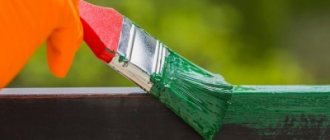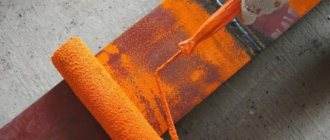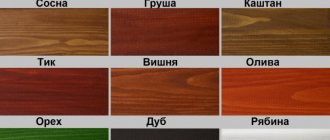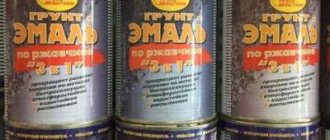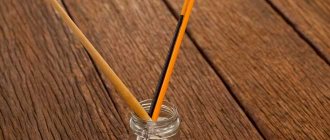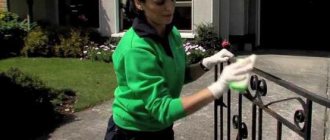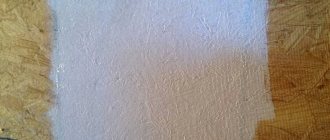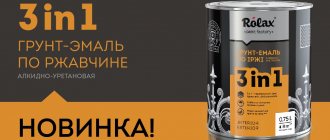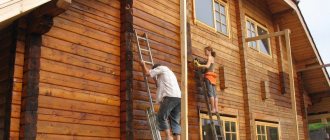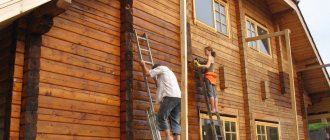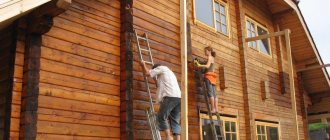Exterior metal and rust paints are used for surfaces that cover large areas or have complex shapes that make them difficult or impossible to completely remove corrosion from. Such compositions easily adhere to the surface of rusty metal and form coatings that are resistant to wear and abrasion.
Where to buy good anti-corrosion paint for rust? In the Arlind online store you will find the best wear-resistant paints for galvanized, non-galvanized metal and rust for exterior work at competitive prices with delivery in Moscow and throughout Russia. Our assortment includes products from Tikkurila, Hammerite, Teknos, Tex and other brands.
Types and characteristics of rust paints
The mechanism of the appearance and growth of corrosion is simple. The unprotected surface of the metal, interacting with water and oxygen, begins to oxidize. Its structure changes, becomes loose and porous, and loses its visual appeal.
Rust
But external manifestations of corrosion are half the trouble. The pores of rusted metal attract moisture even more and better retain it inside, accelerating destructive processes. As a result, the product loses strength and its service life is reduced.
Rust paint
Conventional anti-corrosion paints and varnishes protect metal well from rust, creating a moisture-impermeable film on its surface. But in order for them to adhere well to the surface and perform their functions efficiently, the products must be cleaned of the destroyed layer before applying them, then covered with an anti-corrosion primer, and only after it has dried with paint.
Composition of primer-enamel
The composition of the paint mixture includes special plasticizers, synthetic resins, anti-corrosion pigments, organic solvents, modifiers and various improving additives. Each of the main paint components performs its own task:
- Anti-corrosion primer increases the adhesion of the corroded base to the paint composition, leveling minor defects and leveling the base.
- A rust converter removes corrosion from the surface and prevents it from spreading further.
- Enamel performs a decorative function and protects the metal from the effects of the external environment.
Without a doubt, the 3 in 1 composition can be called a unique achievement of the chemical industry and ranks one of the first places among paint and varnish compositions.
The difference between rust paints and regular metal paints
Multi-stage processing takes too much time, requires large material and physical costs, which is not always justified. A less labor-intensive, and often more economically advantageous, way to protect metal has become the use of special paints that can be applied directly to the rust, bypassing the preparatory stages.
Packages with this paint are marked “3 in 1”. This means that the composition performs three functions at once:
- converts rust particles;
- primes the surface;
- creates a monolithic decorative waterproof layer on it, which is also resistant to various chemical compounds.
3 in 1 paint can
Rust paint has several important advantages, many of which are not available in conventional decorative compositions intended for metal products.
- It can be applied to metal already affected by corrosion. It is not necessary to completely remove the rust to expose the intact layer.
- The protective layer created by the paint repels not only water, but also dirt, maintaining the neat appearance of the product.
- Such compositions are characterized by high adhesion - they stick well to the damaged surface and create a uniform covering layer on it.
- The service life of such coating is usually very long - from 3 to 15 years. It depends on the composition and manufacturer.
Like regular decorative coatings, paints that can be applied directly to rust are available in a wide variety of colors and shades.
Paint can be applied directly to rusty metal
What is metal corrosion
Compared to wood and stone, metal is a universal material for giving products any shape; it is resistant to fire, temperature changes, and aggressive environments. For a long time without any treatment, it retains its appearance when exposed to atmospheric conditions.
- Then it gradually corrodes and becomes covered with rust. The appearance of the product is gradually deteriorating.
- Under the influence of rust, pieces of metal fall off and irregularities form: roughness, gouges.
- Oxygen and humidity penetrate deeper and deeper. Reacting with new layers of iron and oxidizing it.
If rust is not dealt with, it gets inside the product and begins to corrode the metal from the inside. Its damaged texture becomes brittle.
To prevent this from happening, metal objects must be processed in a timely manner. In this case, the protected surface will retain its original beautiful appearance for a long time, remaining smooth and durable.
Types of anti-corrosion paints: composition
The properties and scope of application of rust paints are determined by their composition. And mainly - the type of base. Based on this criterion, they are divided into oil, alkyd, acrylic, and epoxy.
- Alkyd paints one of the most inexpensive. Along with very high adhesive properties, this is their main advantage over other compounds designed to protect ferrous and galvanized metal surfaces. The main disadvantages are flammability and instability to high temperatures.
“Nerzhamet” – primer-enamel for rust 3 in 1 - Oil paints are made using natural oils and drying oils. They cope worse than other coatings in protecting surfaces exposed to aggressive atmospheric influences from rust: precipitation, temperature changes, and sunlight. Therefore, they try not to use them for exterior decoration.
- Epoxy paints, unlike alkyd ones, are produced on the basis of silicone polymer resins that are resistant to high temperatures. But the volatile toxic substances they contain do not allow them to be used for painting structures inside residential and public buildings. Epoxy compounds are mainly used for painting outdoor elements.
Epoxy paints - Acrylic paints based on polymer resins and anti-corrosion modifying substances. They are universal: they do not have a pungent odor, are characterized by good wear resistance, resistance to heat and moisture. They are used to protect various metal structures both indoors and outdoors.
Find out how to paint a ceiling with acrylic paint, and also check out the characteristics, advantages and preparatory work in a special article on our portal.
Prices for anti-corrosion paints
Anti-corrosion paints
Recommendations from experts
Considering the huge number of metal surfaces, experts recommend several important points to consider:
- When painting radiators and heating pipes, it is better to choose heat-resistant types of paints and varnishes;
- It is better to paint heating pipes before the start of the heating season;
- Furnace parts are also painted with materials that are resistant to high temperatures;
- Surfaces made of non-ferrous metals must be coated with a special coating. soils;
- When working with industrial objects in the fresh air, organic solvents are suitable.
Anti-rust coatings for the population are modern protective products that allow you to extend the service life of metal products. The use of these special compounds allows you to save a lot of time on cleaning the coating. Using anti-corrosion enamel on metal, you can get good results with minimal investment.
Review of anti-corrosion paints (2 videos)
Products from different manufacturers (32 photos)
Types of paints: method of application
The consumption of paint compositions depends on the method of application. This can be done using the traditional method - with a roller or brush. If the paint can be sprayed, its consumption is reduced to 20-30%. And aerosol paints in spray cans are characterized by increased consumption.
Aerosol paint
The choice of method depends on the type of surface to be painted. For example, solid metal parts with a large area to be painted can be painted as desired, but openwork parts are more convenient to spray paint on. It is also easier to paint hard-to-reach places with a spray bottle.
Note. If the surface is properly prepared and the painting conditions are observed, the durability of the finished coating will be the same regardless of the method of applying the paint.
Advantages and disadvantages
Let's take a closer look at the advantages and disadvantages of the material that are typical for all manufacturers.
The undeniable advantages of primer-enamel over classical protective coatings (meaning primer GF-021 and enamel PF-115) include the following points:
- Surface preparation is greatly simplified when using an anti-corrosion compound. Its application does not require thorough cleaning of rust-affected areas and additional surface treatment with a special modifier, followed by its neutralization with a soda solution. Primer enamel can be applied even to residual rust; it is enough to remove the peeling coating and loose corrosion formations from the surface being treated.
- The decorative and protective properties of the material are noticeably higher than those of alkyd coatings. Alkyd-urethane varnish, acting as a binding element, has greater hardness, wear resistance and is less susceptible to moisture and aggressive environments than alkyd varnish used in primers such as GF-021 and enamel PF-115.
To ensure reliable anti-corrosion protection for 5 years, it is necessary to apply one layer of GF type primer and two layers of PF-115 enamel, while enamel primer is sufficient to apply in two layers. When applying three layers, the service life of the decorative protective coating increases to 7 years.
- The use of the material can significantly reduce the time required for painting work. It should be recalled here that the GF-021 primer dries within 12 hours, and one layer of PF-15 enamel completely polymerizes in 24 hours. Thus, to obtain a protective coating it will take: 12+24+24=60 hours.
One layer of the composition at an ambient temperature of 200C does not exceed 6 hours, which allows you to completely complete painting work in 12 hours.
- All components of the protective coating (rust modifier, primer and enamel) are in one can, which greatly simplifies their application and reduces the number of tools required.
The main, and perhaps the only, disadvantage of primer-enamel is their high cost, however, upon closer examination, this disadvantage also turns out to be quite dubious. The fact is that the estimate for painting work takes into account not only the price of the material. It also takes into account the cost of preparatory work and application of each individual layer.
When using this composition, the preparatory work is significantly simplified, and the protective and decorative coating itself is applied not in three, but in two layers, so the total cost of the work differs slightly.
Popular rust paints
Among the many brands of special rust paints, there are those that are especially popular. It is determined not only by positive customer reviews, but also by sales volume.
Hammerite
This brand is a confident leader, despite its fairly decent price. This is due to the quality of the coating, its durability, beautiful texture and versatility. Hammerite anti-corrosion paints are used for decorative finishing of ferrous, galvanized and non-ferrous metals, wood, and plastic. They are used for finishing external and internal structures. Apply to new and previously painted surfaces.
Hammerite paints
When choosing paint of this brand, you should pay attention to the series.
- Hammered - These are hammer paints that create the effect of hammer chasing on the painted surface. It turns out shiny, but textured and rough, which perfectly masks minor defects. This effect is achieved by adding aluminum powder and small glass fractions to the composition. Hammer compounds are ideal for painting ferrous metal.
Anti-corrosion hammer enamel for rust
Hammered paint shades - Smooth – a series that forms smooth glossy or semi-matte films. In addition to ready-made paints in standard shades, you can purchase a base composition for tinting in your own color.
Hammerite Metal Paint Smooth
“Lakra” Hammer Effect
Another effective protective agent with a hammer consistency. Made on an alkyd-styrene base, it is characterized by its low price and good adhesion to metal surfaces with a rust layer thickness of up to 0.1 mm. It can also be used for painting wooden structures, creating a coating with a metallic sheen on them.
“Lakra” Hammer Effect
Alpina Direkt Auf Rost
Universal paint from the well-known company Caparol for decorating metal surfaces indoors and outdoors. It is easy to apply and has good resistance to fading.
Alpina Direkt Auf Rost
“Nerzhamet”
Alkyd paint Nerzhamet is available in regular form and in aerosol cans. It contains polymer inclusions, is very easy to apply, dries quickly and adheres well to the rust-affected surface, forming a hard semi-gloss film. Its service life without the need to renew the coating is six years.
Anti-corrosion paint for metal
"Prestige". Primer-enamel
Another inexpensive domestic product, characterized by a high drying speed, high resistance to moisture and other aggressive environments, and economical consumption of a maximum of 120 grams per square meter. Diluted with solvents such as xylene or R-4 to the desired consistency.
"Prestige". Primer-enamel
This paint is actively used for finishing galvanized metal roofs, external pipelines and fences.
“Stop rust”
Like most other alkyd enamels, this composition can be applied by any means. Available in packaging of different volumes: buckets, jars, aerosol cans. It is used to paint external structures made of steel and cast iron, including those with old paintwork. Penetrates well into the deteriorating metal structure and blocks the spread of rust.
“Stop rust”
“Cycrol”
Even galvanized steel, when exposed to precipitation, sunlight and aggressive impurities in the air, will corrode over time. To protect it, a special 3 in 1 product “Tsikrol” has been developed, which has high adhesion to such surfaces.
High-quality anti-corrosion primer-enamel based on acrylic resins with polymer additives in organic solvents
It consists of acrylic resins, organic-based solvents and additives that increase the enamel's resistance to wear, moisture, low temperatures, corrosion and other atmospheric influences. It has good coverage, water-repellent properties and the ability to dry quickly after application.
Advice. The paint contains volatile toxins that evaporate into the air from the fresh, not dried composition. Therefore, while working with this product, it is necessary to protect the respiratory system and skin.
Paints and enamels for rust
How to choose the right one and where to buy 3 in 1 enamel paint
Studying reviews and communicating with experienced painters will help you choose the right three-in-one paint for rust. If this is not possible, then we advise you to trust the opinion of the author of this article, who has personally tested and recommends the Russian GOODHIM NOVAX® MULTICOAT ANTICOR. We do not claim that this is the best product on the market, but we can guarantee that it corresponds to the stated qualities and description.
This company uses only innovative production technologies, has installed the world's best conveyor lines and machines, and employs young chemists, engineers, and developers. Gudhim offers favorable conditions for wholesale buyers; all products are certified and protected from counterfeiting.
Anti-corrosion treatment of metal is a necessary stage of its finishing. If previously such treatment was carried out in several stages and required the work of a competent painter, now it is enough to simply apply a special primer-paint with the effect of converting rust. New building materials are already on the shelves, it's time to start using them.
Heat-resistant paints
Not all rust paints can withstand high temperatures. They are designed for heating no higher than 40-60 degrees. But metal structures such as stoves, barbecues, fireplaces, pipes and radiators, car parts and other equipment also need protection from corrosion.
To decorate them you need to use heat-resistant and heat-resistant paints. The degree of their stability is determined by the composition of the components. Among these dyes there are also several different types.
| Types of heat-resistant paints | Composition and application |
| Alkyd paints with the addition of zinc and phosphate compounds are designed to withstand temperatures up to 100 degrees. They can be used to paint heating system elements - radiators and pipes that do not heat above 90 degrees. | |
| Epoxy compounds can withstand temperatures up to 200 degrees. Some of them require an anti-corrosion primer to be applied. Can be used to create a protective coating on components and parts of technical equipment. | |
| Epoxy ester and ethyl silicate paint compositions with metal powder as additives can withstand a maximum temperature of 400 degrees. And one-component silicone based on polymer resins - up to 650 degrees. These are suitable paints for the protective and decorative finishing of outdoor barbecues. | |
| The most heat-resistant paints contain particles of composite materials and heat-resistant glass. They are used to paint metal stoves and fireplaces that can heat up to 800-1000 degrees. |
Prices for heat-resistant paints
Heat-resistant paints
It is important! In the vast majority of cases, all these structures should be painted in a cold state, and heated after the coating has completely dried. Although there are paints that require heat to polymerize. Therefore, carefully read the instructions with recommendations for use.
Alkyd weatherproof anti-corrosion paint Tikkurila Panssarimaali
Panssarimaali metal paint from Tikkurila contains highly effective anti-corrosion pigments, so it can be applied over rust. Used for outdoor work. The product can be purchased for a durable finish on pre-primed steel, aluminum, and galvanized metal surfaces. Suitable for roofs, drainpipes, railings, and other metal structures. The composition is successfully used in humid climates and in industrial environments.
The coating formed by Panssarimaali metal and rust paint significantly slows down the corrosion process. It is chemically resistant: it can withstand exposure to alcohol, lubricating oils, turpentine and white spirit. After complete drying, the surface can be washed using conventional detergents.
Decorating metal structures using rust paint
Three-in-one metal paints can be applied to any metal structures, even those damaged by corrosion. In this case, pre-treatment with a special primer is not necessary, because such paints already have the properties of this composition. In addition, they convert rust into a monolithic layer and are excellent decorative materials.
Coverage scheme
Thanks to these features, painting any metal structures with such paint is much easier than with conventional compositions that require careful preliminary preparation of the metal surface.
Regardless of the application method, the work procedure consists of only a few steps.
Step 1.
The metal surface is cleaned from dirt and the flaking upper rusty layer using a stiff brush, spatula or sandpaper with coarse abrasive.
Removing rust mechanically
Step 2.
The cleaned product is wiped with a solvent, moistening a cloth or sponge in it. And let it dry.
Solvent surface treatment
Step 3.
Preparing the paint involves mixing it thoroughly. Or shaking the can if using an aerosol. It is advisable to rub a brush with natural bristles on sandpaper so that poorly adhering bristles fall out and do not remain on the paint coating.
Useful life hack
The paint must be mixed thoroughly
Step 4.
The paint is applied to the surface in an even layer and allowed to dry for the time specified in the instructions.
Applying paint
Step 5.
Then apply a second layer, trying to avoid drips.
Second layer
The difference between rust paint and regular enamel
If the paint is applied with a spray gun or sprayed from a spray can, then more layers will be required - at least three. Between them it is necessary to observe a time interval for drying.
Prices for paint sprayers
Spray gun
The can or gun should be shaken before work and periodically during work, and the sprayer should be kept at a distance of 20 cm from the surface to be painted.
The modern market of finishing materials is constantly updated with new products that simplify the work of finishers and have improved decorative and operational characteristics. Rust paint is a prime example of such innovation.
How to prime correctly
The priming process can be divided into preparatory and main stages:
When preparing, it is necessary to sand the surface, remove dust, dirt, and mold from it. If necessary, dictated by the instructions for the primer composition, the wall must be degreased: for this use acetone or similar solvents
During preparatory work, it is important to maintain proper ventilation of the room and temperature conditions within the range of 5-25°C. The main stage of priming is to dilute the required amount of the composition and apply it to the walls.
How many times
The primer is usually applied in two layers, the first of which is thicker, and the second is necessary to better strengthen the surface
It is important to dry each layer of primer for the time recommended on the packaging (usually several hours)
What to prime
Depending on the porosity of the wall, you can prime it with a brush or roller.
Each method has its own advantages.
A brush allows you to work on unplastered surfaces, while a roller gives a uniform, smudge-free layer, which requires less primer.
How long after can I paint?
The minimum time for drying the primer should be found in the instructions for the specific composition; it usually ranges from 4 hours.
If repair work allows, then it would not be superfluous to let the primer soak in during the day.
In addition, if the primer composition was applied to plaster or putty, then subsequent painting should be carried out only after all layers of finishing have completely dried.
Drying of the primer can be slowed down by open containers filled with water in the room, so it is better to remove buckets of water, remnants of diluted primer and other liquids from the room.
Best Oil Paint for Exterior
Tikkurila Teho oil paint , created on an alkyd basis, is used for treating external wooden surfaces exposed to intense weather conditions. Suitable for covering fences, railings, cladding boards. After drying, the surface acquires a pleasant semi-gloss shine. In addition, the coating does not lose color over time and does not crack. The use of paint provides reliable protection of wood from mold and contamination. During the work, smudges are almost completely eliminated, and the long drying time allows you to effortlessly level the fresh layer to a perfectly even state.
Tikkurila Teho comes in a white and colorless base, which allows you to choose the right shade for any wooden surface. During processing, the relative air humidity should not exceed 80%, and the temperature should not be less than 5°C.
Characteristics
- Gloss – semi-gloss.
- Consumption – from 6 to 11 m2/l, depending on the surface being treated.
- Drying time – 24 hours under normal conditions.
- Density – about 1.3 kg/l.
- Dry residue – about 62%.
pros
- Large selection of colors.
- Weather resistant.
- Does not fade when exposed to direct sunlight.
Minuses
- Price.
paints and varnishes
0 votes
+
Vote for!
—
Vote against!
Despite the emergence of many new materials manufactured in accordance with methods developed in the age of innovative technologies, metal, which is ubiquitous as an external finishing material, does not plan to lose its position. However, its specific characteristics necessitate the introduction of paint and varnish materials in the construction industry that prevent premature failure of metal surfaces, which, despite the strength and durability of the metal, is not uncommon. Metal structures have become an integral element of multi-apartment buildings, the design features of which imply the presence of metal water and heating pipes, as well as metal fences on balconies and stairwells. Suburban construction uses metal structures even more actively - small architectural forms, greenhouses, gates and window bars - all of this is made mainly of metal. The choice of metal is determined by its unique characteristics, including mechanical strength, increased resistance to high temperatures, and relative availability. Despite many advantages, metal also has its vulnerabilities, the presence of which determines the use of paint for metal and rust.
Content
- About rust and ways to combat it
- Classification of paints and varnishes for metal
- Anti-corrosion paints: scope and characteristics
- Advantages of rust paint
- Features of hammer paint for rust
- Applying anti-corrosion paint to the surface: preparation
- Primer enamel for rust: features
- Method of applying anti-corrosion paint
- General recommendations for applying paint to metal and rust
About rust and ways to combat it
As you already understand, the main disadvantage of metal is its low resistance to corrosion, which is expressed not only in the deterioration of the appearance of metal structures, but also in a shortening of its service life. In order to understand the principle of action of anti-corrosion agents, let's consider the basic terminology. Rust is the result of oxidative processes occurring on the surface of the metal. Metal structures undergo oxidation when the air contains a large amount of water vapor, under the influence of which the strength of the metal decreases and its original attractiveness is lost. Progressive corrosion, penetrating into the material, attracts moisture and is retained inside the metal due to its porous structure. How to deal with the destruction of metal, which, with constant contact of the material with an aggressive external environment and the absence of special measures to prevent the destruction of the metal, will only progress?
Traditional methods of metal protection involve cleaning off rust, after which the metal surface is treated with anti-corrosion primer and only then with protective paint. However, from the point of view of material and time costs, these measures are not always justified, which necessitates the search for new, cost-effective and less labor-intensive ways to protect metal from corrosion. And they were found. Today, the procedure in this situation looks somewhat different.
To avoid the progressive destruction of the material, paint and varnish compositions are used that are designed to prevent the oxidation process on the metal surface.
Classification of paints and varnishes for metal
Before we consider in detail the characteristics and use of rust paint, let’s consider the main types of metal paint:
- Epoxy enamels;
- Oil paints;
- Alkyd paints;
- Acrylic paints.
Epoxy enamels, due to the toxicity of their constituent components, are used extremely rarely in everyday life. The material, made on the basis of silicone resins, is designed to protect metal structures from exposure to high temperatures.
Oil paints, the main components of which are drying oil and natural oils, due to their low resistance to temperature changes, are intended mainly for interior finishing work. This limits their use as a material for external finishing work, since oil paints will not provide adequate protection of metal structures from corrosion.
Alkyd paints used for painting galvanized metal surfaces also have their own advantages and disadvantages. Despite the fact that alkyd paints are characterized by the greatest adhesive ability, they are not resistant to high temperatures and are extremely flammable.
Despite the fact that acrylic paints for metal are characterized by a relatively recent appearance on the market, they are currently characterized by growing popularity, which is explained by a number of functional characteristics of this type of paint and varnish materials. Due to their durability and guaranteed protection of metal from corrosion, they are used for both internal and external finishing work. In addition, they demonstrate their effectiveness when painting heating elements and other high-heat parts.
Anti-corrosion paints: scope and characteristics
As you may have guessed, not all metal paints are capable of providing optimal protection of the material from corrosion and premature loss of its original characteristics. In this regard, when considering the classification of paints for metal, it is necessary to separately consider the stand-alone paint for rust. Among consumers, the most popular representative of this group is Hammerite rust paint.
Knowledgeable developers, whose goal is to carry out repair work with minimal economic costs, prefer to buy rust-resistant paint to protect metal from rust. This will not only allow you to avoid carrying out rather labor-intensive and expensive work, which is not always justified, but will also significantly simplify the technological process of applying an anti-corrosion coating. Rust paint, the price of which depends on the manufacturer and the technical type of paint and varnish material, is a quick-drying one-component paint made on the basis of epoxy-modified synthetic resins with the addition of anti-corrosion pigments, which provides the most effective and durable anti-corrosion protection and a finishing coating with high decorative characteristics .
Thanks to a carefully selected composition of synthetic resins by a team of specialists, the use of Hammerite rust paint allows you to obtain a glossy, semi-matte and hammer finish, the features of which will be discussed below. The main advantage of this coating is its ability to resist the accumulation of dirt, which plays an important role in the formation of rust. The scope of application of anti-rust paint is extremely wide: today it is used both in private construction and in the industrial industry, for example, for painting roofing systems, gas and water pipes, equipment, machine tools and agricultural tools, as well as other metal structures in need in anti-corrosion protection.
The inclusion of high molecular weight silicones in the paint provides additional properties of the paint, the essence of which is to prevent the negative effects of moisture on metal surfaces. The wetting properties of the paint make it possible to apply it to completely unprepared metal surfaces. The operating temperatures of metals treated with an anti-corrosion compound are between -20 and +80 degrees, which, coupled with resistance to destruction under the influence of ultraviolet radiation, allows the use of rust paint in hot and humid climate zones.
Advantages of rust paint
Let's summarize the above and highlight the main advantages of rust paint:
- Possibility of application directly onto rusty surfaces and poorly prepared surfaces;
- The ability of paint to form a weather-resistant coating characterized by water- and dirt-repellent properties;
- High covering ability;
- High level of adhesion to surfaces affected by rust;
- Characterized by high corrosion resistance;
- Dries in a short period of time;
- Long service life of the coating, reaching 8 years;
- Wide variety of factory shades.
Despite the large number of advantages, the anti-corrosion coating also has its disadvantages:
- It is prohibited to paint equipment whose operating temperatures exceed 150 degrees;
- The application of anti-corrosion coating to metal structures whose surface is in contact with drinking water is excluded.
Features of hammer paint for rust
The color palette includes a variety of shades, including glossy and semi-gloss colors, semi-matte and hammer shades.
Rust hammer paint got its name due to the fact that the surface coated with it visually resembles the surface of a hammer head, that is, it is characterized by the same barely perceptible roughness and metallic sheen. The production of hammer paint is carried out using alkyd-styrene, acrylic and epoxy bases, and with the addition of fine glass and aluminum powder.
Due to the increased resistance of hammer paint to high humidity, temperature fluctuations and vibration, hammer paint is used to treat the surfaces of industrial equipment, as well as to create durable anti-corrosion coatings not only for ferrous, but also non-ferrous metals. The main advantage of hammer paint is the ability to be applied directly to rust without prior preparation and the creation of an airtight protective film due to the content of special binders.
Applying anti-corrosion paint to the surface: preparation
The work process when applying anti-corrosion coating is standard. Since the surface to be painted must be clean, dry and free of grease, it is recommended to carry out standard preparation before painting, which involves cleaning the surface with a wire brush in two directions or evenly passing sandpaper along the contact surface of the material. Having examined the surface condition for the presence of sharp corners and discovered large residual irregularities, they are removed using a crusher. However, experts do not recommend getting carried away with such drastic techniques as using a crusher and drill with an appropriate attachment, as they can cause damage to the metal surface and even compromise its integrity. Surfaces that have previously been painted should be cleaned not only of dirt, dust and grease, but also of old paint, after which it is thoroughly washed with water and dried.
If you're dealing with surfaces that have rust, the next step is choosing the best method to remove the rust before painting. If you use paint that contains a rust converter to protect a metal surface from corrosion, there is no need to focus on existing rust and achieving a metallic shine on the treated surface, since this type of anti-corrosion paint converts rust residues, the thickness of which does not exceed 30 microns , into a layer of primer.
Despite the fact that rust paint manufacturers claim that their products can be used without prior priming, we advise you not to refuse to apply a layer of primer, which helps to increase the adhesive ability of the anti-corrosion paint and extend the service life of the applied coating. Another thing is primer paint for rust, the application of which does not require preliminary priming.
Primer enamel for rust: features
It is practiced to apply primer-enamel to various types of surfaces made of metal, including those damaged by rust, without necessarily applying a primer first. This is due to the primer-enamel effect, called “three in one,” that is, primer paint for rust combines the properties of a primer for metal, anti-corrosion paint and enamel for metal. As a result, the procedure for working with primer-enamel is significantly simplified:
- The metal surface is cleaned of dirt, dust and grease, as well as the top layer of rust, which will require the use of a metal spatula, brush or sandpaper, and wiped with a solvent.
- The primer-enamel is first thoroughly mixed and applied to the metal sequentially in two layers. In this case, before applying the second layer, wait 30 minutes, which is the minimum period of interlayer drying time, which can be extended up to 5 hours. If after 5 hours you have not been able to apply the second coat of primer-enamel, you must postpone its application for another 30 days.
Method of applying anti-corrosion paint
Before applying paint, the surface is thoroughly degreased using a solvent and dried. Experts recommend paying attention to the environmental conditions that are most optimal for painting. The recommended air humidity should be at least 80%, and the ambient temperature should be 20 degrees above zero. Professionals who have experience working with anti-corrosion paints advise not to pay attention to the manufacturer’s recommendations, according to which work with paint can be carried out at temperatures of 20 degrees below zero, since these recommendations are relevant mainly for force majeure circumstances.
- After cleaning the surface, the anti-corrosion paint is thoroughly shaken and a solvent is added in a ratio of 9:1. If you are using Hammerite paint, experts recommend using Hammerite Brush Cleaner & Thinners. The paint is applied in three layers, with the second applied three hours after applying the first layer, otherwise, the application of the second layer of paint is postponed for 6 weeks. Failure to follow these recommendations will result in unevenness on the painted surface. If these recommendations are neglected and paint is applied in more than three layers, it may drain from the metal surface, which will lead to a significant reduction in the performance characteristics of the anti-corrosion coating. After applying metal and rust paint, make sure all edges and corners are thoroughly painted.
- If the surface has been previously painted, anti-corrosion paint is applied in two layers in compliance with the above recommendations.
- If you prefer to apply the paint using a spray gun, you can thin the paint with xylene. However, here too the manufacturer must indicate his recommendations: most often the instructions give restrictions on the volume of added solvent depending on the initial volume of paint. In most cases, they make up no more than 15% of the original volume of anti-corrosion paint. Dilution of paint with Nitrocellulose solvent is excluded.
When applying paint using a spray gun, there are also a number of specific recommendations:
- Paint is applied in at least 3-4 layers, with the time interval between layers not exceeding 15 minutes;
- The distance between the surface to be treated and the spray gun must be at least 20 cm, pressure - no more than 2 bar;
- To obtain a homogeneous mass and color, which is necessary for the final coating to be uniform, the gun is thoroughly shaken before and during use;
- Despite the fact that the final layer should be much thicker, it is necessary to strictly ensure that there are no unevenness and that the paint does not settle or flow down the surface.
General recommendations for applying paint to metal and rust
Considering the wide variety of metal surfaces, experts give a number of general recommendations that must be taken into account when working with anti-corrosion paint:
- In the case of painting the radiator and heating pipes, it is necessary to give preference to heat-resistant paint and primer, the operating temperatures of which are within 150 degrees;
- Painting of heating pipes must be done when they are cold, that is, before the start of the heating season;
- Painting stove elements determines the need to use even more temperature-resistant paint, the temperature of which can reach 400-500 degrees;
- Painting surfaces made of non-ferrous metals necessitates the use of special primers, since the usual ones intended for ferrous metals are not suitable;
- In the case of work at industrial facilities carried out outdoors, manufacturers recommend the use of organic solvents.
Tips for surface preparation and application
To obtain a high-quality and durable coating, it is enough to follow the instructions given on the packaging of the material. Below are some tips on how to properly prepare the surface and apply enamel primer.
Unlike labor-intensive surface preparation when painting with conventional enamel, when applying primer-enamel, preparatory work is reduced to removing formation rust and degreasing the surface. Rust is removed, as with conventional painting, mechanically, and it is not at all necessary to achieve a perfectly clean surface. Degreasing is done using solvent or white spirit.
Applying paint is practically no different from applying other paints and varnishes. To obtain the desired result, you must adhere to the following rules:
- when applying two or more layers, before applying each subsequent layer, you should wait until the previous one has completely dried;
- Painting work can be carried out at a temperature of at least +50C, otherwise the viscosity of the substance will increase significantly, which will not only complicate the application, but will also lead to the formation of drips. If the room temperature exceeds +300C, setting may occur before the composition is evenly distributed over the surface.
- since any organic solvent is more or less toxic, work should be carried out either in the open air or in a well-ventilated area.
